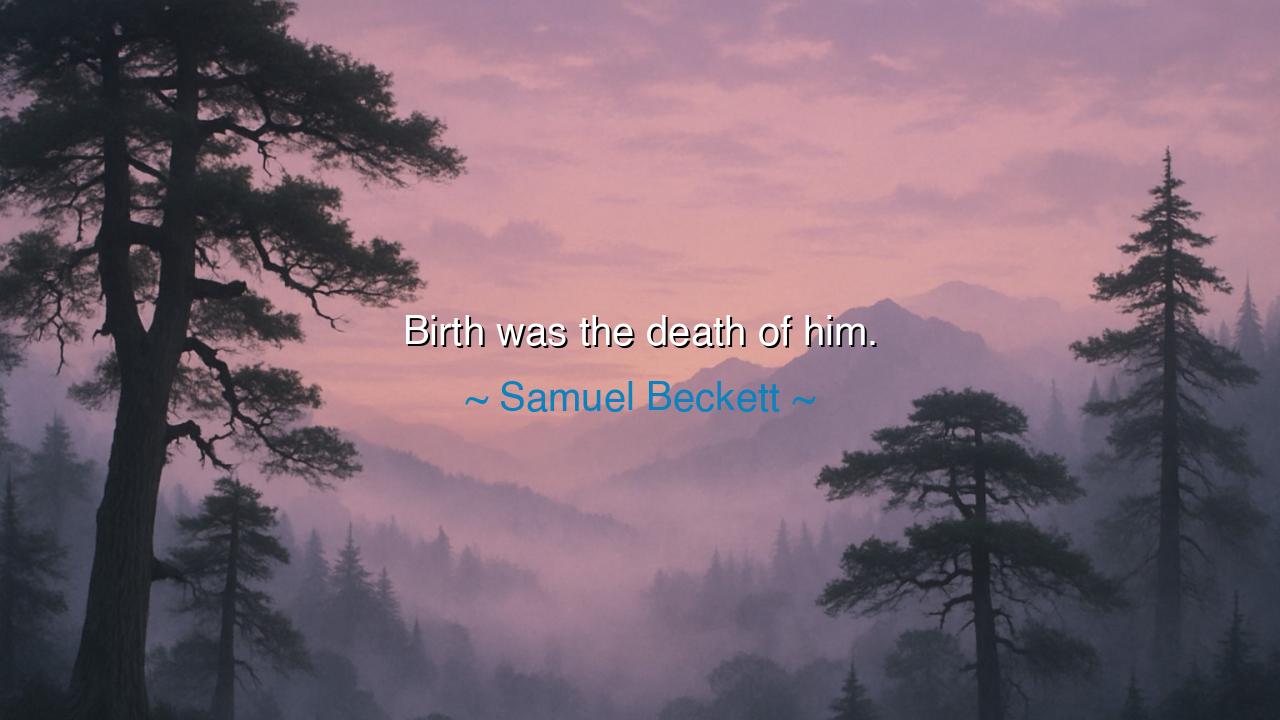
Birth was the death of him.






“Birth was the death of him.”
Thus wrote Samuel Beckett, the poet of despair and the prophet of existence, who looked upon the human condition not with the eyes of illusion, but with the cold, piercing gaze of truth. In this brief and terrible phrase, Beckett captures the paradox of life itself—that the moment we are born, the seed of death is planted within us. From the first cry that announces our arrival, the slow unraveling of our mortal thread begins. The cradle and the grave are not distant ends of a journey; they are bound together, two halves of the same circle.
The origin of this thought lies in Beckett’s philosophy of existential absurdity—a belief that life itself is both miraculous and meaningless, a dance between being and decay. To be born, he implies, is to begin dying; to awaken to consciousness is to awaken also to the awareness of suffering. Every heartbeat brings us closer to stillness. Yet Beckett does not speak these words to plunge us into despair, but to compel us toward understanding. He asks us to see that mortality is not a punishment, but a truth—a reminder that life, fragile and fleeting, must be lived with honesty and courage.
To comprehend this idea, one need only look to the story of Prince Siddhartha Gautama, who would become the Buddha. Sheltered from the sight of pain and death, he once believed life was eternal joy. But when he finally beheld sickness, old age, and the corpse of a man, the illusion shattered. He saw that all who are born must die, that birth itself carries the shadow of ending. Yet this realization did not destroy him—it transformed him. From sorrow, he drew wisdom; from impermanence, compassion. Beckett’s grim truth, though stripped of comfort, holds the same seed of awakening. To face death is to truly see life.
Indeed, every artist, philosopher, and lover who has looked deeply into the heart of being has felt this tension between birth and death. They are not enemies but twins—one cannot exist without the other. The flame that gives light also consumes its wick. The river that flows toward the sea loses its name in the merging. To be alive is to be in the process of ending; yet it is also to be in the process of creating. In this paradox lies the mystery of existence—the beauty and the sorrow intertwined.
Beckett’s words can seem cruel, but they are not without tenderness. For in acknowledging that life is inseparable from death, we learn to cherish each fleeting moment. The man who fears death spends his days in chains; the one who accepts it walks freely under the sun. When we recognize that we are dying from the moment of birth, each breath becomes precious, each act of kindness eternal. Mortality, far from diminishing us, gives meaning to our days—it is the boundary that sharpens the shape of love, art, and purpose.
Think of those who have lived with this awareness and turned it into greatness. Vincent van Gogh, tormented by pain and madness, painted as if every stroke might be his last. His life burned swiftly, yet his art became immortal. In his suffering, he embodied Beckett’s truth: that existence and decay are one, and that the beauty of life lies not in escaping death, but in creating something luminous before it arrives. So too can we, in our small ways, transform the inevitability of ending into the radiance of meaning.
So, O seeker of truth, do not recoil from Beckett’s dark wisdom. Let it awaken you. See that to be born is to begin dying, and yet, within that dying, to begin truly living. Do not waste your brief spark in fear or denial; instead, live deliberately, love deeply, create boldly. Let every word, every touch, every act be worthy of the price you pay for being alive. For though birth may have been the beginning of death, it also marked the beginning of the miracle—that you exist, that you can choose, that you can shine, if only for a moment, before returning to the silence from which all things came.






AAdministratorAdministrator
Welcome, honored guests. Please leave a comment, we will respond soon